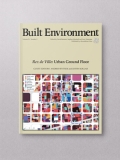Managing the Urban Century
About this issue
Summary
This issue of Built Environment is devoted to the strategic question of how the complex evolution of cities can be managed, with a view to achieving sustainable development, economic vitality, cohesive social capital and strong infrastructural connectivity in modern urban agglomerations.
A universal feature of the worldwide revolution is the movement of people into urban settlements at an ever faster rate. World population increases by 2 per cent a year, urban population by over 4 per cent. In the next forty years, more urban construction will take place than hitherto in the whole history of man. It is already evident that wrong projections of urban development produce inexcusable waste. The absence of any forecasts leads to chaos in the cities, to the undermining of civic order and the destruction of precious and diverse historical traditions. Thus the need for the rational and dynamic planning of human settlements both now and in the foreseeable future is inherent in the urban situation today.
Article 4 of the The Declaration of Delos, 1963
Our world becomes increasingly an urban world and our era becomes increasingly an urban century. The urban way of life will soon be shared by some 60 to 70 per cent of the world population. The urban century’ is not the result of an autonomous megatrend, but finds its genesis in rapid changes in population demography, in environmental transformation, and in economic and globalization forces.
The urban century prompts a wide array of research and policy challenges regarding sustainability of cities, public facilities and infrastructure, as well as social cohesion. Both the drivers and the impact of the urban century need thorough examination. Some scholars resort to scenario or urban imaging experiments to map out the uncertain futures of our urban world. Others use expert opinion on value experimentation to come to grips with the multitude of uncertainties regarding the future of urban agglomerations. We witness also an increasing interest in the question how to manage the urban century, while taking into consideration that cities are not isolated islands, but part of a broader global, demographic and socio-economic development. These entities also display different ‘faces’ in different parts of the world. There is indeed considerable interest in the study of urban futures and urban morphological dynamics.
This special issue of Built Environment is devoted to the strategic question of how the complex evolution of cities can be managed, with a view to achieving sustainable development, economic vitality, cohesive social capital and strong infrastructural connectivity in modern urban agglomerations. This issue comprises seven varied contributions on the above theme. We will briefly outline the structure of this issue.
The first contribution by Hans Westlund provides a general, but original overview of current urbanization trends and related policy and scientific challenges.
Next, Sujata Shetty and Neil Reed argue that modern urbanization trends do not contradict old industrial development in current cities, but may even be in tandem, especially in case of proactive urban strategies.
In the study which follows, Luigi Fusco Girard highlights how regional cities, in particular, provide a new perspective on the broader footprints of modern urban areas in a complex global context.
It is indeed a fact that urban development takes place in a complex force field. This observation is supported by Sigrun Kabisch and Christian Kuhlicke, who position urban dynamics against the backdrop of resource efficiency, quality of life, and resilience.
Cities are manmade constructs, but always accommodate a rich variety of natural capital. Daniel Czamanski, Dan Malkinson and Marina Toger in their article focus on the importance of nature for future cities, and offer an important planning agenda.
Modern urban agglomerations are the stage for rapid socio-economic transformation, but are also confronted with their past historical and cultural heritage. Karima Kourtit, Cathy Macharis and Peter Nijkamp present the issues involved with the protection and exploitation of older industrial areas in cities, by applying a geo-mapping multi-criteria approach to Amsterdam.
Finally, Sasa Dobricic, Viviana Martini and Marco Acri present a new perspective on future urban landscapes from the perspective of far reaching urban transformations, now and in the future.
This special issue makes a convincing case that the urban century will not be ‘more of the same’, but will prompt profound changes in the foundation and functioning of our urban world. The face of our planet will rapidly change in the next few decades. Managing the urban century will certainly not allow for a passive laissez-faire. On the contrary, the formidable challenges will call for a proactive policy strategy that is driven by the motto ‘forewarned is forearmed’.

